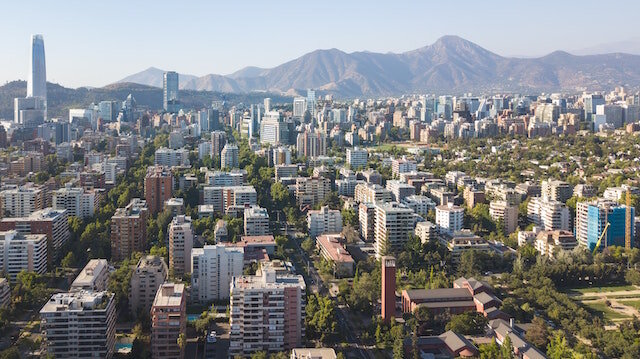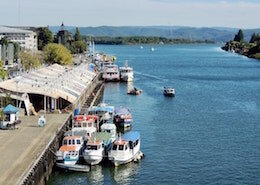Southern Chile
Is Chile considered a third world country?
The term ‘Third World’ arose during the Cold War to define countries that remained ‘non-aligned’ with the Communist Soviet bloc or the Capitalist NATO bloc. By this original definition, Chile is a ‘Third World' country, as Chile remained neutral during the Cold War era.
However, today there is no clear or agreed-upon definition of the term Third World. Based on current metrics, such as the Human Development Index (HDI) score, which takes into account:
A long and healthy life: What is the life expectancy at birth, for example
Being knowledgeable: Average years of schooling and education across the population
A decent standard of living: Gross National Income (GNI) and average purchasing power relative to other countries
The Republic of Chile (officially) by this metrics ranks 42nd out of 189 countries and would thus be considered a FIRST WORLD nation by their HDI ranking.
Blue - “First World” - Yellow - “Second World” & Red - “Third World” based upon countries HDI score. Chile ranks 42, which falls into the “First World” category by this updated metric representation.
Classification of 1st, 2nd & 3rd world: origins
The ‘Three-Worlds’ model was a geopolitical mapping of the world as a way to deal with the post-colonial situation that emerged after World War II. The First World of capitalism versus the Second World of socialism/communism were both vying to pass on their ideologies to the neutral Third World countries.
Santiago - Chile’s Capital and largest city
Historians usually credit French demographer Alfred Sauvy as the originator of the term Third World, from his 1952 article entitled, Three Worlds, One Planet. This article gave us:
The First World, which included the United States and its capitalist allies in Western Europe, Japan, and Australia.
The Second World consisted of the communist Soviet Union and its Eastern European allies.
The Third World encompassed all the other countries that were ‘not-aligned ’ during the Cold War. These neutral nations were mostly impoverished former European colonies and included the nations of Africa, the Middle East, most of Asia, and Latin America.
Third World originally referred to countries that had not formally aligned with one of the two superpowers, the United States and the Soviet Union. However, Switzerland, Sweden, Austria, Finland, and Ireland all remained neutral during the Cold War, and none of these countries have ever been called Third World…..
What does “third world” mean today?
“There is at the very least a numerical absurdity in speaking of a Third World when there is no longer a Second World. ”
Today, Third World is used synonymously with terms like underdeveloped, developing, frontier market, and a host of similar words.
The term Global South was coined as an alternative to Third World and is used by the World Bank and other political institutions. The ‘logic’ behind this term is that most of the world’s poverty is located in the Southern Hemisphere.
The South, Third world, or developing countries are all terms that are used interchangeable and generally reference nations that are lesser developed with higher levels of poverty.
Puerto Varas, Chile
Chile’s place in the “Three Worlds” Model: History
Looking through the lenses of Latina America, the end of World War II brought two great antagonistic blocs; the capitalist bloc of North America versus Soviet socialism. This left the rest of the world as nothing more than pieces in a global game of chess.
In 1961, The First Summit of the Non-Aligned Movement (NAM) took place in Belgrade, which brought together countries that sought to “depart” from the influence of the great powers and to counterbalance Soviet and American positions. The NAM arose after World War II as the two superpowers tried to safeguard and amplify their areas of influence.
Chile’s President (1970-1973) Salvador Allende
Chile joined the Non-Aligned Movement in 1971 by the decision of Chile’s socialist President Salvador Allende. A 2000 CIA bulletin entitled “CIA Activities in Chile," from the United States CIA.gov website, says:
"Efforts by the United States to support anti-Communist forces in Chile date back to the late 1950s and reflect the rivalry between the United States and the Soviet Union for influence throughout the Third World. The growing strength of the Chilean left, along with continuing fragmentation by conservative and moderate political forces, became increasing concerns through the 1960 70s to the United States, which wanted to avoid the emergence of “another Cuba” in the Western Hemisphere." (bolding is mine)
Chile today & economic inequality
Even though Chile’s Human Development Index score ranks 42 out of 189 countries, Chile has one of the highest levels of inequality in the world.
Chile’s Patagonia
Globally, Chile is often touted as an “economic success story” since they are highly industrialized and are a major exporter. Since the 1970s, Chile has diversified its commodity-dependent economy of mainly copper into a wide range of products for export, such as forestry, salmon, seafood, fresh fruit, and most famously their wine.
Between 1973 and 1989, Chile was under the dictatorship of General Pinochet, becoming a democratic nation in 1990. However, governmental policies from Pinochet’s 16-year reign created a small group of elites that controlled the vast majority of wealth and power……and these same people/families still have the control even to this day.
The riots and protests that made the world news in 2019 was the result of years of living under a democratic system that still closely resembles the authoritarianism of the 70s and 80s. As little has changed for the Chilean people over the last 30 years.
Luis Bértola and Jeffrey Williamson say in their book, Has Latin American Inequality Changed Direction?:
"The extremely rich elite, whose economic and political power is similar today to what it was during the oligarchic republic at the beginning of the twentieth century, impose formal and informal rules that undermine Chilean democracy. Even under democracy, the elite have been able to stop the timid attempts made by the government to improve income distribution."
Chile as “2nd World”
Today, most of Latin America is considered Second World or emerging market based upon development status and economic metrics.
Most geopolitical experts consider Chile to be the most developed country in all of Latin America.
Viña del mar, Chile - The coastline of Chile follows along the Pacific Ocean
Flushing the toilet and the ability to drink tap water is standard throughout Chile. As are; paved roads, nationwide public transit, farm/produce food systems, modern medicine, free-public healthcare, and a thriving technology sector.
However, the income inequality, price of education, and overall cost to income ratio are obstacles that stand in the way of progress for most Chileans.
what about the “4th-world”
The term Fourth World was first coined in the 1970s and was used to describe societies that are excluded from mainstream communities and the global economy, such as Aboriginal tribes in parts of South America and Australia.
Unlike the first three worlds, the Fourth World is not geographically bound, as the Fourth World is used to categorize societies within nation-state(s) or designating nations without a sovereign state.
Valdivia, Chile - Home of Pedal Chile
Final Thought
I currently live in Valdivia, which is a beautiful city on the far northern edge of Patagonia.
Valdivia is near 60+ hot springs, several active volcanoes, beaches of the Pacific Ocean, ski resorts in the Andes, a dozen universities, and over 20 areas of natural protection.
While this area is nothing less than First World, over 90 percent of Chileans live in the capital city of Santiago or Valparaíso, in which both cities are over 800 km away. Chile’s Patagonia is a stunning region that is drastically different than the populous central valley.
In the Eagles song Last Resort, they sing “you call someplace paradise, kiss it goodbye.” While no place is perfect and “paradise” is elusive, Chile is pretty alright, regardless of geopolitical labeling.
Jesse is Director of Pedal Chile and lives in Chile’s Patagonia (most of the year). Jesse has a Master of Science in Health and Human Performance and enjoys riding single-track down the active volcano near Pucón. Hobbies: Reading, researching, writing, Dr. Seuss quotes, weight lifting, snowboarding, and enjoying the beauty in the ordinary.
Sources:
Bértola, L. and Williamson, J., n.d. Has Latin American Inequality Changed Direction?.
Cia.gov. 2020. CIA Activities In Chile — Central Intelligence Agency.
Cia.gov. 2020. CIA Machinations In Chile In 1970 — Central Intelligence Agency.
Lebdioui, A., 2019. Chile's Export Diversification since 1960: A Free Market Miracle or Mirage?. Development and Change, 50(6), pp.1624-1663.
Reddit.com. 2020. The First, Second, And Third Worlds Based On HDI For 2015. (map image)
Smithsonian Institution. 2020. Salvador Allende.




















